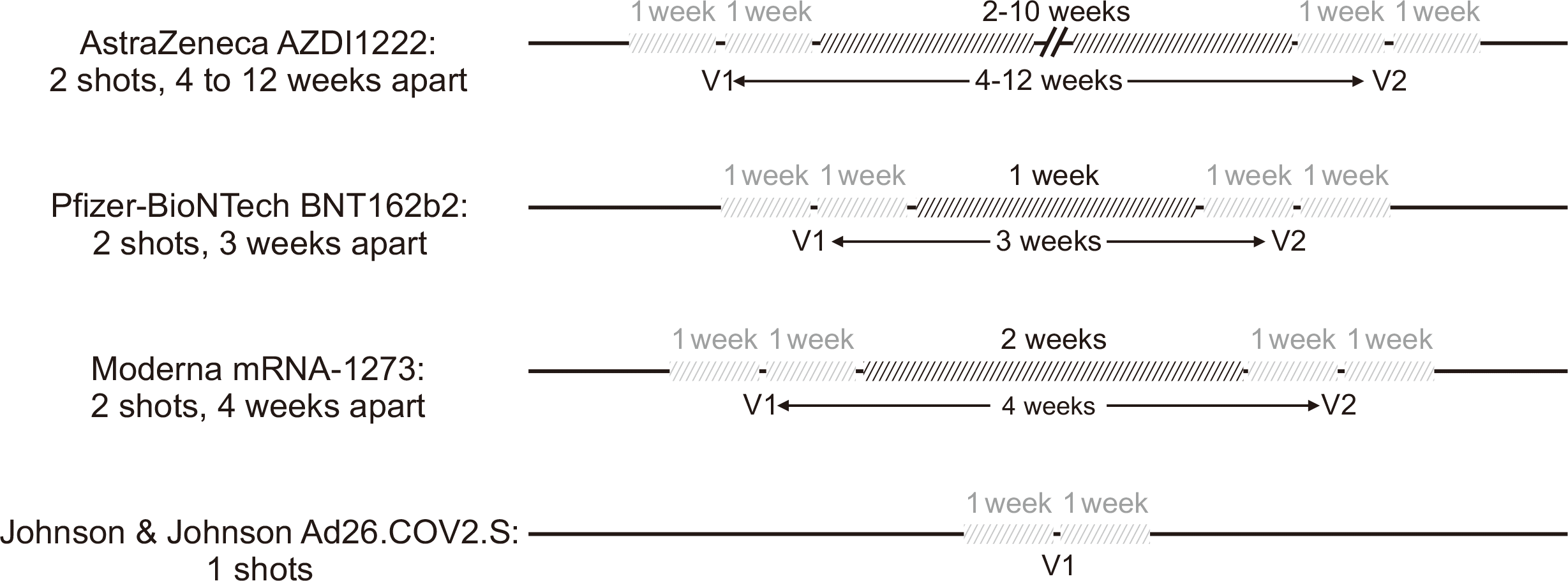1. World Health Organization. 2021. WHO Corona virus (COVID-19) dashboard [Internet]. World Health Organization;Geneva: Available at:
https://covid19.who.int/.
2. Ministry of Food and Drug Safety of Korea. 2021. Information of Corona virus (COVID-19) vaccines in Korea [Internet]. Ministry of Food and Drug Safety of Korea;Cheongju: Available at:
https://www.mfds.go.kr/vaccine_covid19.jsp.
3. Tregoning JS, Brown ES, Cheeseman HM, Flight KE, Higham SL, Lemm NM, et al. 2020; Vaccines for COVID-19. Clin Exp Immunol. 202:162–92. DOI:
10.1111/cei.13517. PMID:
32935331. PMCID:
PMC7597597.

7. Polack FP, Thomas SJ, Kitchin N, Absalon J, Gurtman A, Lockhart S, et al. 2020; Safety and efficacy of the BNT162b2 mRNA Covid-19 vaccine. N Engl J Med. 383:2603–15. DOI:
10.1056/NEJMoa2034577. PMID:
33301246. PMCID:
PMC7745181.

8. Lee H, Punt JA, Miller DC, Nagpal A, Smith CC, Sayeed Y, et al. 2021; Do corticosteroid injections for the treatment of pain influence the efficacy of mRNA COVID-19 vaccines? Pain Med. 22:994–1000. DOI:
10.1093/pm/pnab063. PMID:
33605425. PMCID:
PMC7928682.

9. Strehl C, Ehlers L, Gaber T, Buttgereit F. 2019; Glucocorticoids-all-rounders tackling the versatile players of the immune system. Front Immunol. 10:1744. DOI:
10.3389/fimmu.2019.01744. PMID:
31396235. PMCID:
PMC6667663.

10. Akondy RS, Fitch M, Edupuganti S, Yang S, Kissick HT, Li KW, et al. 2017; Origin and differentiation of human memory CD8 T cells after vaccination. Nature. 552:362–7. DOI:
10.1038/nature24633. PMID:
29236685. PMCID:
PMC6037316.

11. Lindgren G, Ols S, Liang F, Thompson EA, Lin A, Hellgren F, et al. 2017; Induction of robust B cell responses after influenza mRNA vaccination is accompanied by circulating hemagglutinin-specific ICOS+ PD-1+ CXCR3+ T follicular helper cells. Front Immunol. 8:1539. DOI:
10.3389/fimmu.2017.01539. PMID:
29181005. PMCID:
PMC5693886.

12. Hartley GE, Edwards ESJ, Aui PM, Varese N, Stojanovic S, McMahon J, et al. 2020; Rapid generation of durable B cell memory to SARS-CoV-2 spike and nucleocapsid proteins in COVID-19 and convalescence. Sci Immunol. 5:eabf8891. DOI:
10.1126/sciimmunol.abf8891. PMID:
33443036. PMCID:
PMC7877496.

13. Ingawale DK, Mandlik SK. 2020; New insights into the novel anti-inflammatory mode of action of glucocorticoids. Immunopharmacol Immunotoxicol. 42:59–73. DOI:
10.1080/08923973.2020.1728765. PMID:
32070175.

14. Kubiet MA, Gonzalez-Rothi RJ, Cottey R, Bender BS. 1996; Serum antibody response to influenza vaccine in pulmonary patients receiving corticosteroids. Chest. 110:367–70. DOI:
10.1378/chest.110.2.367. PMID:
8697835.

15. Herron A, Dettleff G, Hixon B, Brandwin L, Ortbals D, Hornick R, et al. 1979; Influenza vaccination in patients with rheumatic diseases. Safety and efficacy. JAMA. 242:53–6. DOI:
10.1001/jama.1979.03300010037025. PMID:
312949.

16. Coutinho AE, Chapman KE. 2011; The anti-inflammatory and immunosuppressive effects of glucocorticoids, recent developments and mechanistic insights. Mol Cell Endocrinol. 335:2–13. DOI:
10.1016/j.mce.2010.04.005. PMID:
20398732. PMCID:
PMC3047790.

18. Fischer L, Gerstel PF, Poncet A, Siegrist CA, Laffitte E, Gabay C, et al. 2015; Pneumococcal polysaccharide vaccination in adults undergoing immunosuppressive treatment for inflammatory diseases--a longitudinal study. Arthritis Res Ther. 17:151. DOI:
10.1186/s13075-015-0663-9. PMID:
26048579. PMCID:
PMC4481118.
19. Yıldız N, Sever L, Kasapçopur Ö, Çullu F, Arısoy N, Çalışkan S. 2013; Hepatitis B virus vaccination in children with steroid sensitive nephrotic syndrome: immunogenicity and safety? Vaccine. 31:3309–12. DOI:
10.1016/j.vaccine.2013.05.004. PMID:
23684838.

20. Hottinger AF, George AC, Bel M, Favet L, Combescure C, Meier S, et al. 2012; A prospective study of the factors shaping antibody responses to the AS03-adjuvanted influenza A/H1N1 vaccine in cancer outpatients. Oncologist. 17:436–45. DOI:
10.1634/theoncologist.2011-0342. PMID:
22357731. PMCID:
PMC3316930.

21. Vormehr M, Lehar S, Kranz LM, Tahtinen S, Oei Y, Javinal V, et al. 2020; Dexamethasone premedication suppresses vaccine-induced immune responses against cancer. Oncoimmunology. 9:1758004. DOI:
10.1080/2162402X.2020.1758004. PMID:
32923115. PMCID:
PMC7458619.

22. Stout A, Friedly J, Standaert CJ. 2019; Systemic absorption and side effects of locally injected glucocorticoids. PM R. 11:409–19. DOI:
10.1002/pmrj.12042. PMID:
30925034.

23. Kang WY, Lee JW, Lee E, Kang Y, Ahn JM, Kang HS. 2019; Systemic effects of fluoroscopically guided epidural steroid injection with dexamethasone. Korean J Pain. 32:178–86. DOI:
10.3344/kjp.2019.32.3.178. PMID:
31257826. PMCID:
PMC6615449.

24. Chucair-Elliott AJ, Carr MM, Carr DJJ. 2017; Long-term consequences of topical dexamethasone treatment during acute corneal HSV-1 infection on the immune system. J Leukoc Biol. 101:1253–61. DOI:
10.1189/jlb.4A1116-459R. PMID:
28115476. PMCID:
PMC5380376.

27. Miller DC, Patel J, Gill J, Mattie R, Saffarian M, Schneider BJ, et al. 2020; Corticosteroid injections and COVID-19 infection risk. Pain Med. 21:1703–6. DOI:
10.1093/pm/pnaa199. PMID:
32699893. PMCID:
PMC7454880.

28. Weitoft T, Rönnblom L. 2006; Glucocorticoid resorption and influence on the hypothalamic-pituitary-adrenal axis after intra-articular treatment of the knee in resting and mobile patients. Ann Rheum Dis. 65:955–7. DOI:
10.1136/ard.2005.041525. PMID:
16769782. PMCID:
PMC1798213.

29. Abdul AJ, Ghai B, Bansal D, Sachdeva N, Bhansali A, Dhatt SS. 2017; Hypothalamic pituitary adrenocortical axis suppression following a single epidural injection of methylprednisolone acetate. Pain Physician. 20:E991–1001. DOI:
10.36076/ppj/2017.7.E991. PMID:
29149147.
30. Iranmanesh A, Gullapalli D, Singh R, Veldhuis JD. 2017; Hypothalamo-pituitary-adrenal axis after a single epidural triamcinolone injection. Endocrine. 57:308–13. DOI:
10.1007/s12020-017-1357-7. PMID:
28674775. PMCID:
PMC5554884.

31. Brill S, Hochberg U, Goor-Aryeh I. 2021; Neuro-axial steroid injection in pain management and COVID-19 vaccine. Eur J Pain. 25:945–6. DOI:
10.1002/ejp.1749. PMID:
33565660. PMCID:
PMC8013309.

32. Chakravarthy K, Strand N, Frosch A, Sayed D, Narra LR, Chaturvedi R, et al. 2021; Recommendations and guidance for steroid injection therapy and COVID-19 vaccine administration from the American Society of Pain and Neuroscience (ASPN). J Pain Res. 14:623–9. DOI:
10.2147/JPR.S302115. PMID:
33716511. PMCID:
PMC7944369.

33. Friedly JL, Comstock BA, Heagerty PJ, Bauer Z, Rothman MS, Suri P, et al. 2018; Systemic effects of epidural steroid injections for spinal stenosis. Pain. 159:876–83. DOI:
10.1097/j.pain.0000000000001158. PMID:
29394207.

34. Hasan SS, Capstick T, Zaidi STR, Kow CS, Merchant HA. 2020; Use of corticosteroids in asthma and COPD patients with or without COVID-19. Respir Med. 170:106045. DOI:
10.1016/j.rmed.2020.106045. PMID:
32843175. PMCID:
PMC7255263.

36. Gharibo C, Sharma A, Soin A, Shah S, Diwan S, Buenaventura R, et al. 2020; Triaging interventional pain procedures during COVID-19 or related elective surgery restrictions: evidence-informed guidance from the American Society of Interventional Pain Physicians (ASIPP). Pain Physician. 23(4S):S183–204. DOI:
10.36076/ppj.2020/23/S183. PMID:
32942785.





 PDF
PDF Citation
Citation Print
Print



 XML Download
XML Download